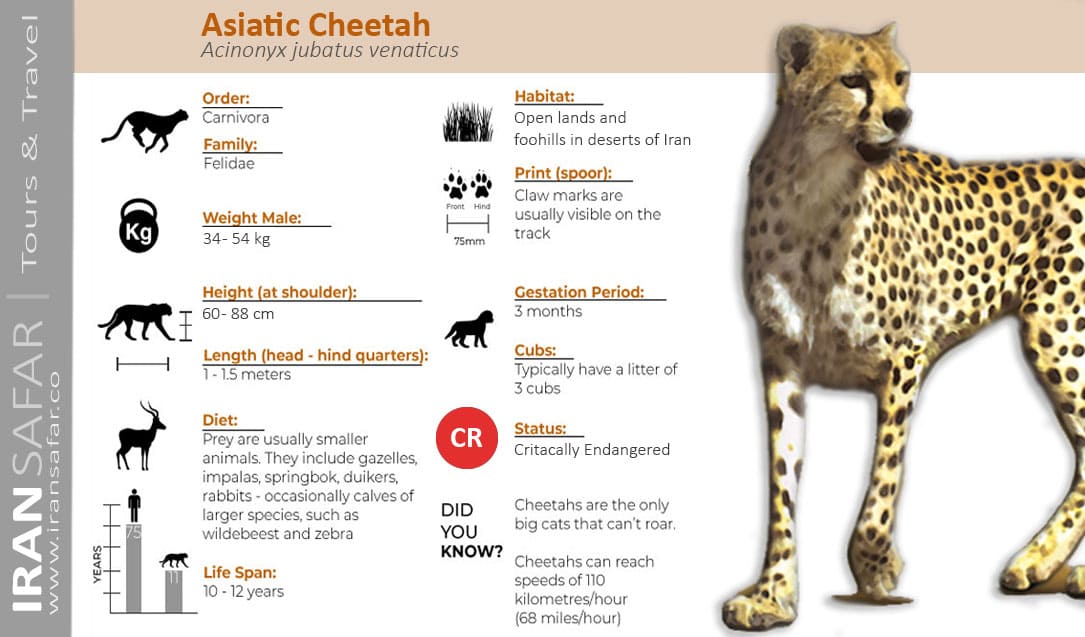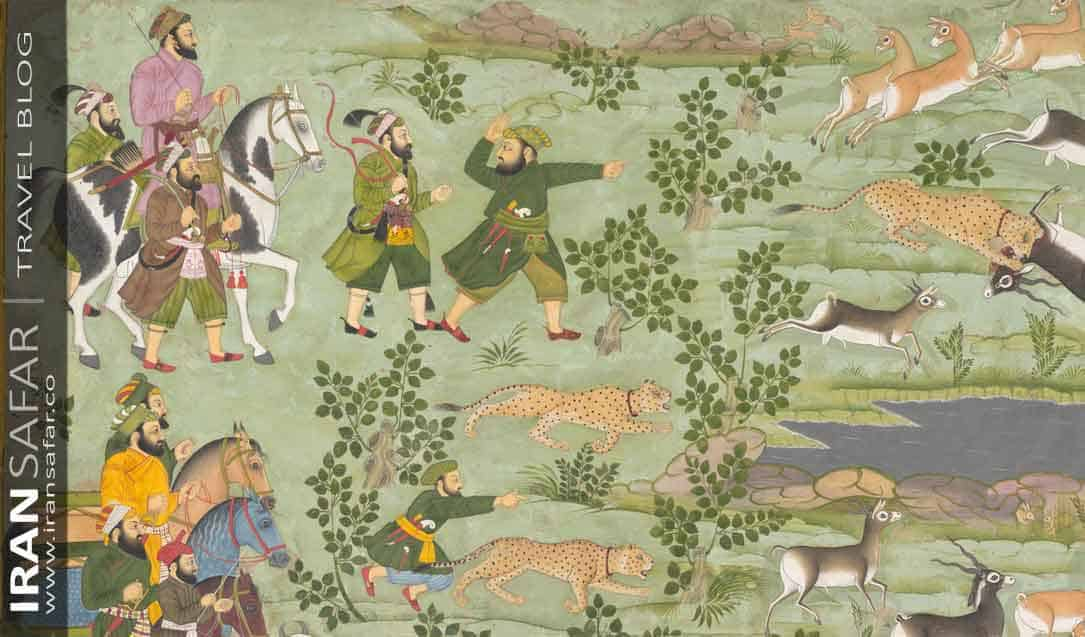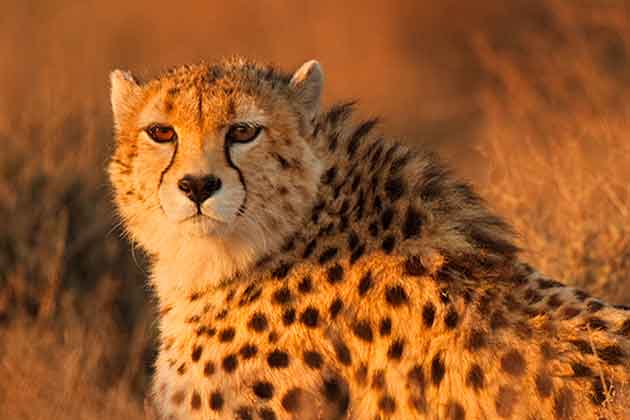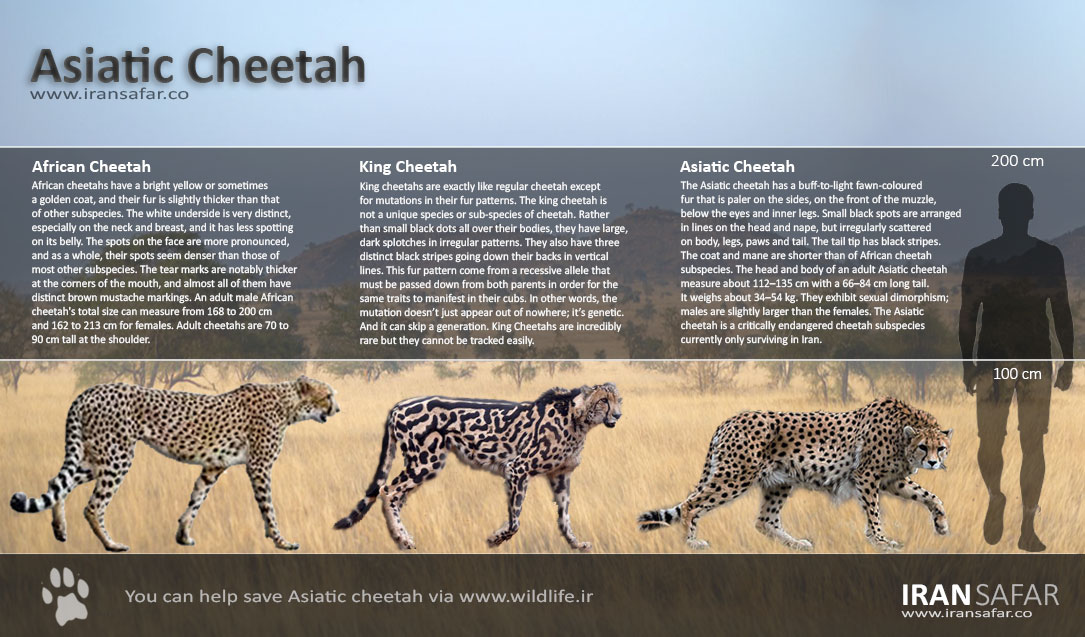The Asiatic cheetah, or the Iranian cheetah, is a critically endangered subspecies of the leopard, of which only a few cubs remain in Iran today.
In general, there are 4 subspecies of cheetah in the world, all of them except the Asiatic cheetah are found in different regions of the African continent. Research shows that Asian cheetahs also lived in the African continent for centuries until they were introduced to the eastern and central Asia about 30,000 to 70,000 years ago.
Asiatic Cheetah or Iranian Cheetah?
Being used to have a wide distribution from North Africa and Arabia to India and Turkmenistan not so long ago, Asiatic cheetah is one of the rarest felines in the world and is under serious threat of extinction due to various human and environmental factors. The country of Iran is considered its last refuge in the world, for this reason the Asiatic cheetah is also known as the Iranian cheetah.
With the extinction of the Asiatic cheetah in Asian and African countries, this mammal became one of the endangered animals, the last examples of which are found in Iran. According to the new researches, there are less than 15 of this subspecies in Iran in an optimistic state, and unfortunately, it is now in the “critically endangered” category of the World Conservation Union.
Also Read – Wildlife of Iran
Asiatic Cheetah Characteristics
Some characteristics of Iranian Cheetah are as follows:
 Asiatic Cheetah Physical Charactristic
Asiatic Cheetah Physical Charactristic
The body of the Iranian cheetah is covered with pale yellow pea colored hair with small black spots. Short hair and dark mane on the head and neck are also considered to be other unique characteristics of the Iranian cheetah. Two black lines extend from the corner of the eyes to the mouth like a tear line, which is known as the ” malar stripes”. These stripes are thicker in the Asian species than in the African species.
Among the other features of Iranian cheetah are small head, long and elongated arms and legs, narrow waist, large chest, long and thick tail and small and round ears. Black stripes can also be seen at the tip of the tail.
The Asiatic cheetah preys on medium-sized herbivores including chinkara, Persian gazelle, wild sheep, wild goat and cape hare. In Khar Turan National Park, cheetahs use a wide range of habitats, but prefer areas close to water sources. This habitat overlaps to 61% with wild sheep, 36% with onager, and 30% with gazelle.
Cheetahs are ranked among social felines. They are mainly active in the mornings and evenings; However, according to recent research, it has been observed that Iranian species is also active at night, especially on moonlit nights. They have very strong vision and can detect the movement of a deer’s tail from a distance of about 2 km.
Unlike most felines, cheetahs do not ambush their prey. It usually spots the prey by eye and after choosing the weakest animal in a herd, it approaches in a crouching manner. Cheetah runs towards the prey with a speed of more than 110 km/h and trips its prey using the dewclaw and proceeds to suffocate it by a bite to the throat. However, the cheetah rarely begins to feed immediately after killing the prey and has to allow its body temperature to decrease through heavy panting. While feeding, the cheetah uses its sharp carnassial teeth to slice the flesh off and eats as much as it can.
Asiatic cheetah is a territorial animal with the territorial tendencies being more pronounced in males than females. The male cheetahs establish territories ensuring maximum access to the females and such territories range from 22 square miles to 62 square miles. The males mark the territorial borders through urine and claw scratches. Unlike most big cats, the Asiatic cheetah lacks the ability to roar but does have other vocalizations including growling. It is used as a display of aggression as well as chirping which is usually an indication of excitement.
Why are Asiatic cheetahs endangered?
Land changes are the most influential factor in the cheetah’s habitat. Harassment by humans, reduction and fragmentation of habitats, expansion of deserts and hunting of food sources of cheetahs such as gazelle and especially illegal hunting of animals for entertainment or for business have been the causes of the decrease of this species. Animal husbandry is also a problem. According to the report of Iran’s department of Environment, in addition to the fact that the herd dogs may attack the cheetah, shepherds may also harm this animal to protect the herd.
The Iranian department of Environment is trying to preserve the Iranian cheetah and has started its conservation program since 2011 to preserve the generation of this valuable species. Currently, the image of the Iranian cheetah as the symbol of the Iranian national football team is emblazoned on the players’ uniforms.
Asiatic cheetah vs African cheetah
In comparison with African cheetah, the Asiatic cheetah is smaller but has a thicker coat, a more powerful neck, and slender legs. Thank to their longer legs, many believe that they could be faster than their African cousins, but no test have proven this theory.
Asiatic cheetah population 2023
The results of research in 2021 show less than 50 cheetahs remain in the marginal areas of the central desert of Iran. This estimate is the result of ground mapping by more than 12,000 night vision cameras deployed in various locations.
Asiatic Cheetah in History
There are historical evidences that reveal the use of cheetahs for hunting. This reflects their significance in various cultures and societies. Cheetahs were not only admired for their grace and speed but were also considered valuable assets for assisting humans in the pursuit of prey.
 Shah Jahan of India, Hunting Scene, Miniature painting
Shah Jahan of India, Hunting Scene, Miniature painting
There are historical accounts and depictions that highlight the close relationship between humans and these majestic creatures:
A seal from ancient Mesopotamia, dating back to the 3rd millennium BC, portrays a cheetah wearing a collar next to its trainer. This indicates the early domestication and utilization of cheetahs in hunting. Assyrian kings were known to employ cheetahs in hunting particularly gazelles. During the Crusades, there are mentions of cheetahs being used for deer hunting in regions such as Syria and Palestine by Crusaders. India’s Mughal Emperors Akbar the Great and Shah Jahan, are said to have possessed around 1000 domesticated cheetahs depicted in various Iranian and Indian miniature art.




Comment (0)